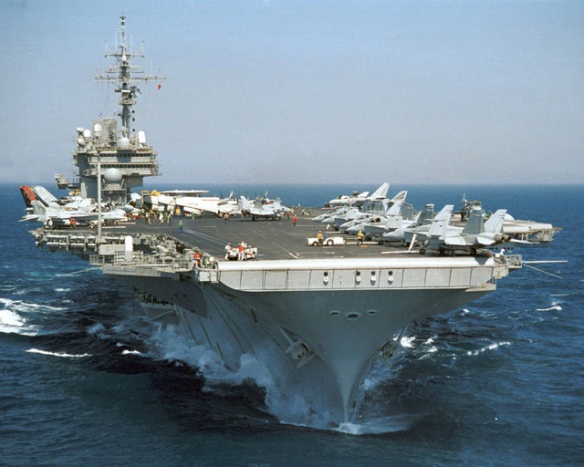Kitty Hawk
Laid down: December 27, 1956. Launched: May 21, 1960. Commissioned: June 9, 1961
Builder: New York Shipbuilding Corporation, Camden, NJ
Constellation
Laid down: September 14, 1957. Launched: October 8, 1960. Commissioned: January 19, 1962
Builder: New York Navy Yard
America
Laid down: January 9, 1961. Launched: February 1, 1964. Commissioned: January 23, 1965
Builder: Newport News Shipbuilding & Dry Dock Company, Newport News, VA
John F. Kennedy
Laid down: October 22, 1964. Launched: May 27, 1967. Commissioned: September 7, 1968
Builder: Newport News Shipbuilding & Dry Dock Company, Newport News, VA
Displacement: 60,100 (61,000 John F. Kennedy) tons (standard), 78,250 (82,000 John F. Kennedy) tons (full load)
Dimensions: 1,062’5” (1,052’0” John F Kennedy) (oa) x 129’4” x 35’0” (36’0” John F. Kennedy) (full load)
Flight deck: 1,040’0” x 252’0”
Machinery: Geared turbines, 8 Babcock & Wilcox (Foster-Wheeler John F. Kennedy) boilers, 4 shafts, 280,000 shp = 33 knots
Bunkerage & range: 7,800 tons = 12,000 nm @ 20 knots
Aircraft: 87
Armament: 2 x twin Terrier SAM launchers (3 x 8-tube Sea Sparrow launchers John F. Kennedy)
Complement: 4,500
Design: The flight deck arrangement of the Forrestal class proved unsatisfactory, since the largest deck park area was abaft the island and landing operations prevent simultaneous egress from the deck park. The revised Kitty Hawk flight deck arrangement reversed the positions of the central starboard elevator and the island, creating a large deck park area ahead of the island that had direct access to the forward catapults at all times. The port elevator was moved aft so that flying operations on the angled deck no longer blocked its use. More powerful C-13 catapults replaced the mix of C-7 and C-11 catapults used in the earlier class. The large forward sponsons for 5-inch weapons were deleted which much improved sea keeping and a pair of twin Terrier missile launchers aft, with forty rounds apiece, replaced all gun armament. The America and the John F. Kennedy both carried large domes at the forefoot for SQS-23 sonar, though the equipment itself was omitted from the John F. Kennedy to cut costs. The John F. Kennedy also had a narrower underwater protection system, originally developed to save space in nuclear-powered carriers. The radar suite for the first two ships comprised SPS-37A air search, SPS-39 three-dimensional search, SPS-8B height finding, and SPG-55 missile fire control. The America carried SPS-43A air search, SPS-52 three-dimensional search, SPS-30 height finding, and SPG-55 missile fire control. The John F. Kennedy carried SPS-43A air search and SPS- 48 long-range three-dimensional search.
Modifications: The Kitty Hawk replaced its Terrier mounts with two 8- tube Sea Sparrow SAM launchers in 1977, and the Terriers were removed from the Constellation and the America in 1982. By 1990 all ships carried three 8-tube Sea Sparrow launchers and fitted Mk. 23 target indication radar for their control. The America’s SPS-52 set was replaced with an SPS-48 radar in 1982. All ships substituted SPS-49 search sets for their SPS-43A radars in 1979–1980. The Kitty Hawk and the Constellation underwent Service Life Extension Program refits in 1988–1991 and 1990–1993 respectively. The John F. Kennedy underwent a Comprehensive Overhaul Modernization, at about half the cost of a full SLEP refit, between 1993 and 1995.
Service: The Kitty Hawk and the Constellation joined the Pacific Fleet on completion and served on Yankee Station during the Vietnam War from 1964 to 1972. The America joined the Atlantic Fleet on completion. It served on Yankee Station between 1968 and 1973. In the Mediterranean, it deployed off Lebanon during the crises in 1976 and 1983 and in operations in the Gulf of Sidra in 1986. The John F. Kennedy joined the Atlantic Fleet on commissioning and served mainly in the Mediterranean, including operations in the Gulf of Sidra during August 1988 that resulted in the destruction of two Libyan MiG-23s. In 1995 it became a reserve carrier but reverted to active status in 2000.
The Constellation was active during the tanker war in the Persian Gulf during 1987. Both the John F. Kennedy and the America served during the liberation of Kuwait in operations Desert Shield in 1990 and Desert Storm 1991. The Kitty Hawk and the Constellation were deployed to the Persian Gulf for Operation Southern Watch between 1992 and 2001. The Kitty Hawk took part in Operation Restore Hope in Somalia in 1992. The Kitty Hawk, the John F. Kennedy, and the Constellation formed part of the task force engaged in Operation Enduring Freedom in 2001, the attack on the Taliban in Afghanistan. The Kitty Hawk and the Constellation also took part in Iraqi Freedom, the invasion of Iraq in 2003.
The Kitty Hawk was home ported at Yokosuka in Japan from 1995. The America decommissioned in August 1996 and was scuttled in 2005.
